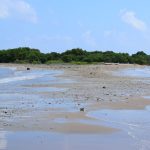Last week, I took a short day trip to the charming little forest patch, the Bodhinagala Forest Reserve. Also home to a monastery, there is an abundance of people around it and plenty of edge habitat. I realized just how sub-urban it is only when a motorcycle hurriedly drove past while I was photographing a pair of Sri Lankan Grey Hornbill (Ocyceros gingalensis), who did not seem to bat an eyelid at the noisy diminutive vehicle revving beneath them. Despite this,
Given the recent calamity at Meethotamulla and the ill-advised decision to dump garbage in Muthurajawela, a wetland sanctuary under the Fauna and Flora Ordinance, it is useful to consider the background to waste management in Sri Lanka. Sri Lanka generates 7000MT of solid waste per day with the Western Province accounting for nearly 60% of waste generation. Each person generates an average of 1-0.4kg of waste per day. According to the Waste Management Authority and the Central Environmental Authority, only half
Last week saw the first UN Ocean Conference, where heads of states, civil society organizations, private corporations and scientists came together to reiterate the importance of the ocean and to facilitate actions for the protection and conservation of oceans, seas and other marine resources. The need for large scale intervention and action to save oceans is pressing. From ocean acidification to mismanagement of marine protected areas to exploitation of fish resources, the threats that this vast vital system faces are
Henderson Island, a tiny remote island in the far flung reaches of the South Pacific Ocean, should bear no trace of human civilization. Instead, the tropical island is covered by a staggering 38 million pieces of plastic trash. Marine debris is mostly made up of plastic, from waterproof sheets to plastic bottles to miniscule micro-plastics found in cosmetic products. Buoyant and durable, plastic is dispersed over vast distances and is found in the most impenetrable corners of the ocean: even
An Ecosystem Based Adaptation Plan against Climate Change and Natural Disasters The weather patterns we are now experiencing is the new ‘norm’; climate change is here to stay. It’s the present, not in the future. Climate projections show that we can expect more severe, unpredictable weather patterns now and in the future. Gone are the days when farmers, businesses, and people could plan their lives and livelihoods based on relatively predictable seasons. Instead, the ‘new norm’ will be erratic and heavy bouts
#WithNature. A simple enough starting point to begin a narrative about where you are, or so the UN thinks. Connecting people to nature is the theme for 2017’s World Environment Day (June 5th) and the aim is to get people to tell stories of their relationships with nature, to celebrate nature and to reconnect with it. It’s the ‘people’s day’ for owning their part as agents of change to protect our shared environment. [1] The aims are admirable
Heavy rains caused landslides in Kithulkanda, Meepe last Thursday, damaging several houses. Previously EFL had conducted a site visit to this area to investigate the exploitative mining on the other side of the Kithulkanda mountain in Meepe , where 15 out of 16 quarries were reportedly violating the terms of their permits. While the Geological Survey and Mines Bureau stated that they would revoke the permits of 15 quarries, EFL learned that they had given permission for 12 quarries to
Funded by the Japan Biodiversity Secretariat, Environmental Foundation Limited generated 16 maps based on biodiversity and socio-economic data as well as development plans of the government of Sri Lanka. These maps include existing protected areas, proposed gaps in protected areas, forest areas important for erosion and flood control, habitat suitability and corridor models, as well as areas identified for commodity agriculture and large scale infrastructure. The purpose of this project was to understand where biodiversity targets will conflict with
Tourism has a symbiotic and occasionally parasitic relationship with biodiversity. Biodiversity pulls in visitors with the wildlife and the aesthetic beauty that is associated with pristine natural habitats and in turn, the revenue generated from tourism can go towards conservation efforts and upkeep of protected areas. However, unchecked and unsustainable tourism degrades natural environments, destroying the very thing that attracted visitors there in the first place. Tourism plays a prominent role in Sri Lanka’s post-war economy, generating $US 2.2 billion
From conserving habitats to preventing illegal wildlife trade, the law is a crucial instrument in protecting Sri Lanka’s biodiversity and ensuring that endangered and endemic species are not forgotten and lost in waves of development. While Sri Lanka is bound by international conventions such as the Convention on Biological Diversity and the Convention on International Trade in Endangered Species of Wild Fauna and Flora, it has a diverse range of domestic legislature under which biodiversity is governed and considered. Biodiversity





